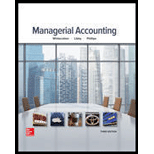
Concept explainers
Concept introduction:
Cost Volume Profit (CVP) Analysis:
The Cost Volume Profit analysis is the analysis of the relation between cost, volume, and profit of a product. It analyzes the cost and profits at the different level of production, in order to determine the breakeven point and required the level of sales to earn the desired profit.
Contribution margin means the margin that is left with the company after recovering variable cost out of revenue earned by selling smart phones. The formula for contribution margin is as follows:
Contribution margin = Sales - Variable cost.
Similarly contribution margin ratio = Contribution/sales
Breakeven Point:
The Breakeven point is the level of sales at which the net profit is nil. It can be explained as a situation where the business is generating a sale that is equal to the expenses incurred and hence no
To indicate:
The Breakeven Point in units without any calculation
Want to see the full answer?
Check out a sample textbook solution
Chapter 6 Solutions
Managerial Accounting
- I need the correct answer to this financial accounting problem using the standard accounting approach.arrow_forwardPlease provide the solution to this financial accounting question using proper accounting principles.arrow_forwardCan you explain the correct approach to solve this financial accounting question?arrow_forward
- I need help with this financial accounting question using the proper financial approach.arrow_forwardOcean Corp. has a single class of shares. As its year ended December 31, 2025, the company had 5,000,000 shares issued and outstanding. On the stock exchange, these shares were trading at around $7. In the company's accounts, these shares had a value of $50,000,000. The equity accounts also show $650,000 of contributed surplus from previous repurchases of shares. On January 15, 2026, Ocean repurchased and cancelled 250,000 shares at a cost of $7 per share. Later in the year, on August 20, the company repurchased and cancelled a further 475,000 shares at a cost of $14 per share. Required Record the journal entries for the two share transactions in 2026.arrow_forwardFinancial Accountingarrow_forward
- In 2027 Palm Tree Inc. declared $1,000,000 in cash dividends. Its capital structure includes 300,000 common shares; 200,000 cumulative preferred shares "A" each entitled to an annual dividend of $1.00; and 50,000 non-cumulative preferred shares "B" each entitled to an annual dividend of $3.00. The prescribed dividends on both series of preferred shares were last declared and paid in 2025. Required Use the following facts to determine how much each of the three classes of shares receives of the $1,000,000 cash dividend.arrow_forwardI am looking for the correct answer to this financial accounting question with appropriate explanations.arrow_forwardPlease explain the solution to this financial accounting problem using the correct financial principles.arrow_forward

 AccountingAccountingISBN:9781337272094Author:WARREN, Carl S., Reeve, James M., Duchac, Jonathan E.Publisher:Cengage Learning,
AccountingAccountingISBN:9781337272094Author:WARREN, Carl S., Reeve, James M., Duchac, Jonathan E.Publisher:Cengage Learning, Accounting Information SystemsAccountingISBN:9781337619202Author:Hall, James A.Publisher:Cengage Learning,
Accounting Information SystemsAccountingISBN:9781337619202Author:Hall, James A.Publisher:Cengage Learning, Horngren's Cost Accounting: A Managerial Emphasis...AccountingISBN:9780134475585Author:Srikant M. Datar, Madhav V. RajanPublisher:PEARSON
Horngren's Cost Accounting: A Managerial Emphasis...AccountingISBN:9780134475585Author:Srikant M. Datar, Madhav V. RajanPublisher:PEARSON Intermediate AccountingAccountingISBN:9781259722660Author:J. David Spiceland, Mark W. Nelson, Wayne M ThomasPublisher:McGraw-Hill Education
Intermediate AccountingAccountingISBN:9781259722660Author:J. David Spiceland, Mark W. Nelson, Wayne M ThomasPublisher:McGraw-Hill Education Financial and Managerial AccountingAccountingISBN:9781259726705Author:John J Wild, Ken W. Shaw, Barbara Chiappetta Fundamental Accounting PrinciplesPublisher:McGraw-Hill Education
Financial and Managerial AccountingAccountingISBN:9781259726705Author:John J Wild, Ken W. Shaw, Barbara Chiappetta Fundamental Accounting PrinciplesPublisher:McGraw-Hill Education





